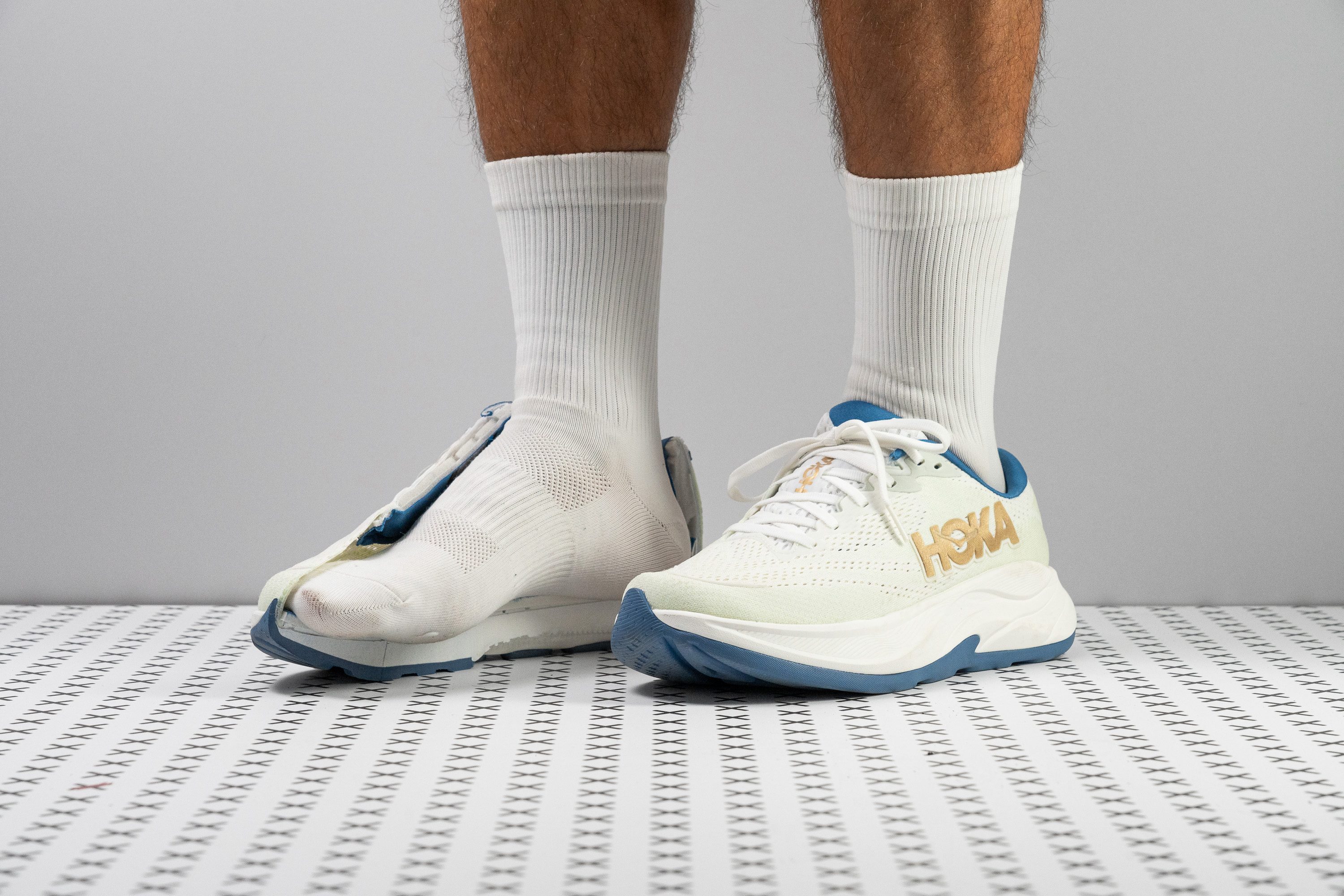Our verdict
- Top pick in best Hoka running shoes
- Top pick in best lightweight running shoes
Pros
- Reasonably priced
- Enhanced stability
- Improved midsole over v3
- Superior breathability
- Still really lightweight
- Increased stack height
- Suitable for everyday activities
- Good traction
Cons
- Poor durability
- Low volume upper
- Weight increase
Audience verdict
- Top 24% most popular running shoes
Comparison
The most similar running shoes compared
+ + Add a shoe | |||||
|---|---|---|---|---|---|
| Audience score | 80 Good! | 88 Great! | 85 Good! | 85 Good! | |
| Price | £110 | £160 | £140 | £140 | |
| Pace | Daily running | Daily running | Daily running | Daily running | |
| Shock absorption | High | - | Moderate | - | |
| Energy return | Moderate | - | Moderate | - | |
| Traction | High | - | High | - | |
| Arch support | Stability | Stability | Stability | Stability | |
| Weight lab Weight brand | 8.1 oz / 231g 8 oz / 228g | 11.6 oz / 329g 11.8 oz / 334g | 10.4 oz / 295g 10.5 oz / 298g | 12.5 oz / 353g 12.2 oz / 346g | |
| Lightweight | ✓ | ✗ | ✗ | ✗ | |
| Drop lab Drop brand | 9.4 mm 5.0 mm | 7.2 mm 8.0 mm | 9.3 mm 8.0 mm | 12.1 mm 12.0 mm | |
| Strike pattern | HeelMid/forefoot | HeelMid/forefoot | HeelMid/forefoot | Heel | |
| Size | Slightly small | Slightly small | Slightly small | Slightly small | |
| Midsole softness | Soft | Balanced | Soft | Firm | |
| Difference in midsole softness in cold | Big | Normal | Big | Small | |
| Toebox durability | Bad | Decent | Decent | Decent | |
| Heel padding durability | Decent | Bad | Bad | Good | |
| Outsole durability | Bad | Good | Decent | Good | |
| Breathability | Breathable | Moderate | Moderate | Moderate | |
| Width / fit | Narrow | Medium | Medium | Medium | |
| Toebox width | Narrow | Wide | Medium | Medium | |
| Stiffness | Moderate | Stiff | Moderate | Stiff | |
| Torsional rigidity | Stiff | Stiff | Moderate | Stiff | |
| Heel counter stiffness | Stiff | Stiff | Stiff | Moderate | |
| Rocker | ✓ | ✗ | ✗ | ✗ | |
| Heel lab Heel brand | 36.0 mm 33.0 mm | 39.1 mm 41.0 mm | 36.8 mm 38.0 mm | 36.5 mm 36.0 mm | |
| Forefoot lab Forefoot brand | 26.6 mm 28.0 mm | 31.9 mm 33.0 mm | 27.5 mm 30.0 mm | 24.4 mm 24.0 mm | |
| Widths available | NormalWide | NormalWide | NarrowNormalWideX-Wide | NarrowNormalWideX-Wide | |
| Orthotic friendly | ✓ | ✓ | ✓ | ✓ | |
| Season | SummerAll seasons | All seasons | All seasons | All seasons | |
| Removable insole | ✓ | ✓ | ✓ | ✓ | |
| Ranking | #313 Bottom 16% | #143 Top 38% | #218 Bottom 42% | #222 Bottom 41% | |
| Popularity | #87 Top 24% | #283 Bottom 24% | #32 Top 9% | #186 Top 50% |
Who should buy
We've thoroughly tested the Hoka Rincon 4 and are excited to recommend it for:
- Newcomers to Hoka seeking a cost-effective entry point into this brand—it's even versatile enough for walking or going to the gym if running doesn't suit you.
- Those who desired more cushioning in previous versions, as it offers ample stack height for enhanced comfort during long runs.
- Runners needing mild support at a reasonable price. This shoe handles various paces smoothly, making it suitable for diverse training needs.
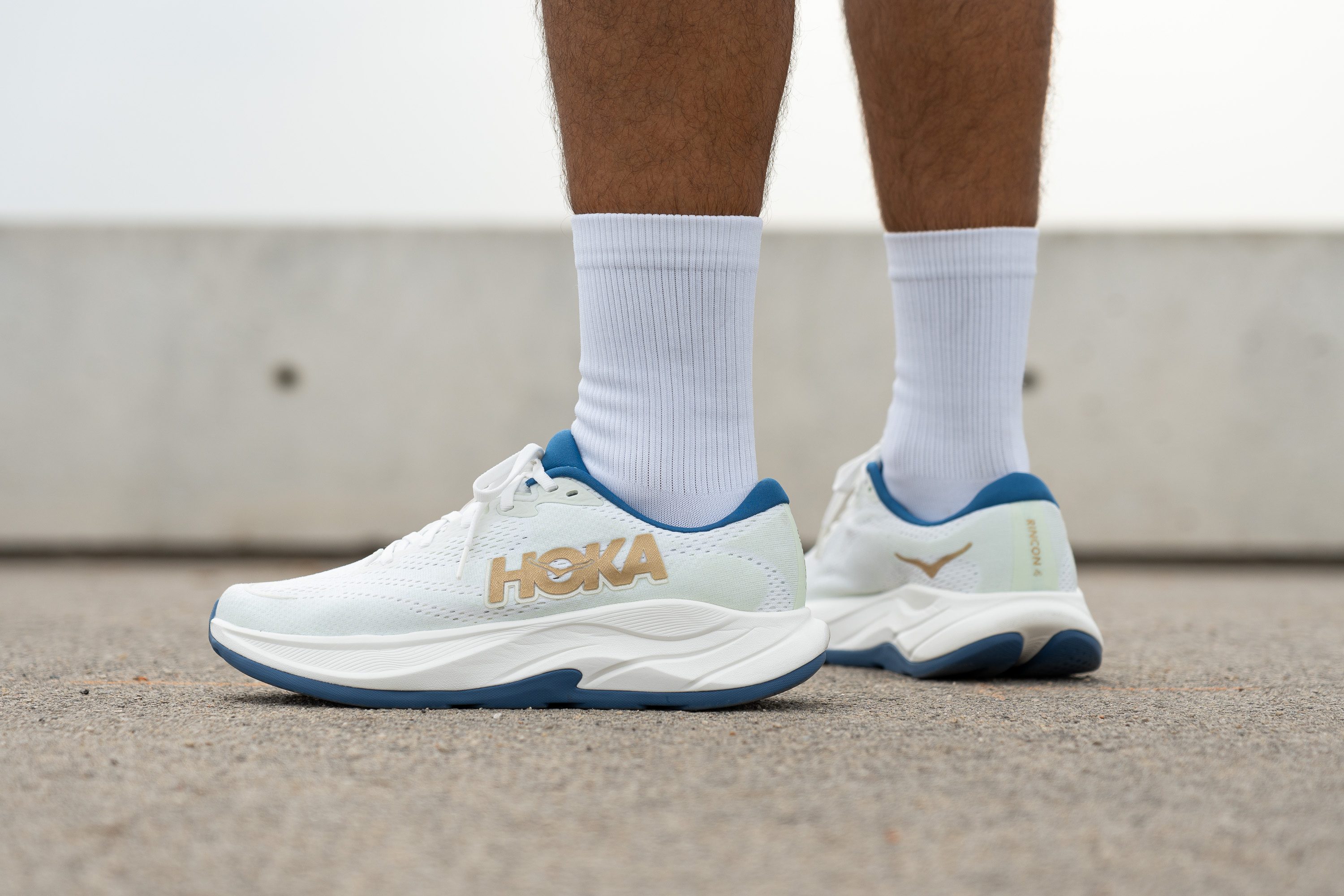
Who should NOT buy
We discovered that the Rincon 4's toebox may not be the best for those who prefer roomy and high-volume shoes, as it tapers more than usual and offers less volume inside. For those who find this problematic, we recommend considering the ASICS GT 2000 12, a reliable player in the mild-stability shoe arena that provides a more accommodating fit with higher vertical volume.
However, there is one concern that stands out with the Rincon 4—its durability. If you are someone who tends to wear out shoes quickly, stay away from this one. The Saucony Guide 17 and the Brooks Launch GTS 10 offer significantly better durability from heel to toe and even better stability underfoot.
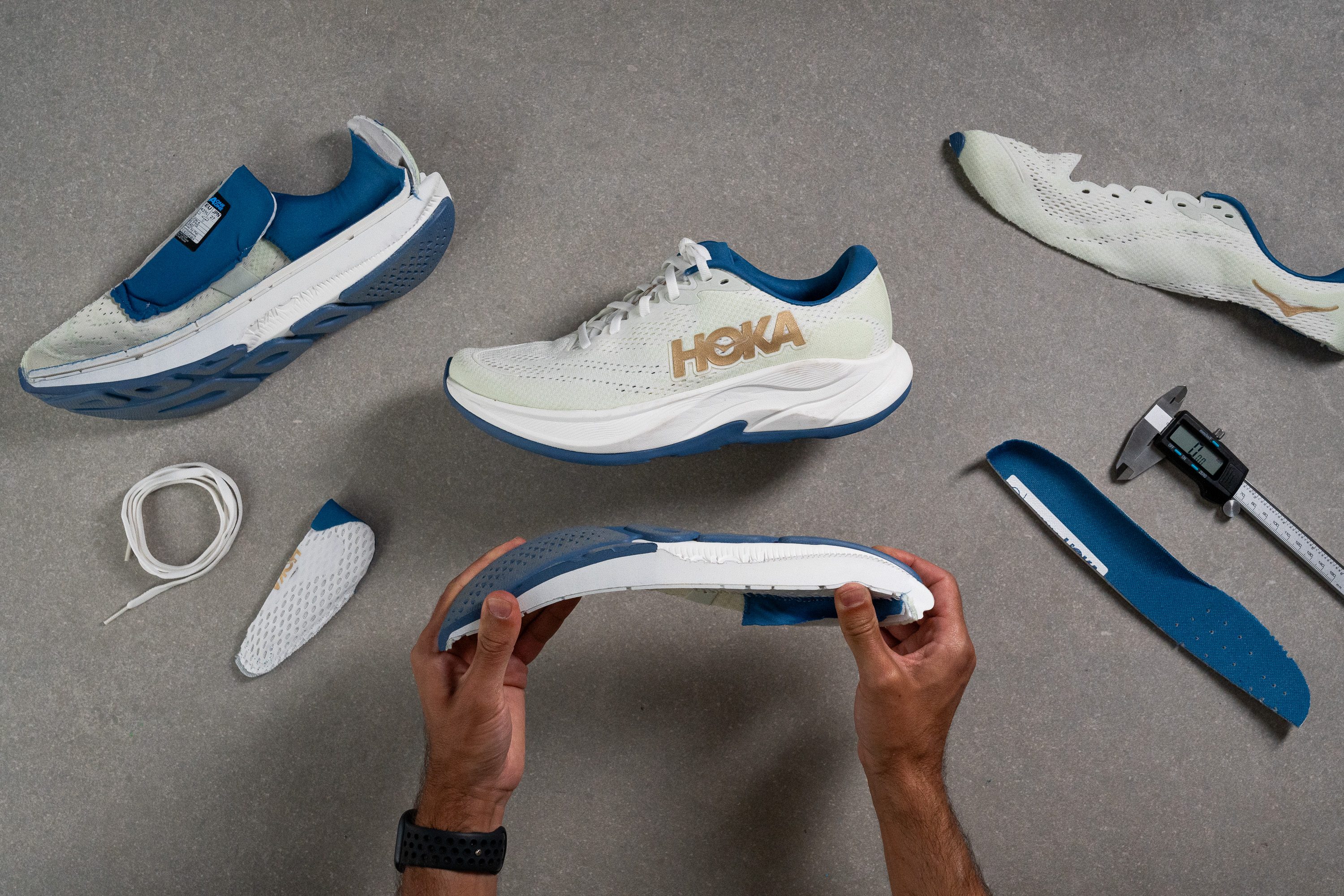
Cushioning
Shock absorption
The Rincon 4 now boasts excellent shock absorption, hitting 134 SA in the heel and 114 SA in the forefoot. These are strong numbers that make version 4 a great pick for long runs.

| Hoka Rincon 4 | 134 SA |
| Average | 129 SA |
Energy return
One of our biggest complaints about version 3 was its lacklustre energy return, but version 4 brings a solid upgrade. It now delivers 56.4% in the heel and 58.8% in the forefoot, which is much better than its predecessor.
| Hoka Rincon 4 | 56.4% |
| Average | 58.5% |
Heel stack
Fortunately, we quickly discovered where the extra weight originated. Using our callipers, we measured a stack height of 36.0 mm in the heel of the Rincon 4, a significant increase from the previous version's 31.8 mm.
This enhancement is a good one for virtually every runner, particularly beneficial over long distances. Heel strikers, in particular, will find this increased cushioning exceptionally rewarding.
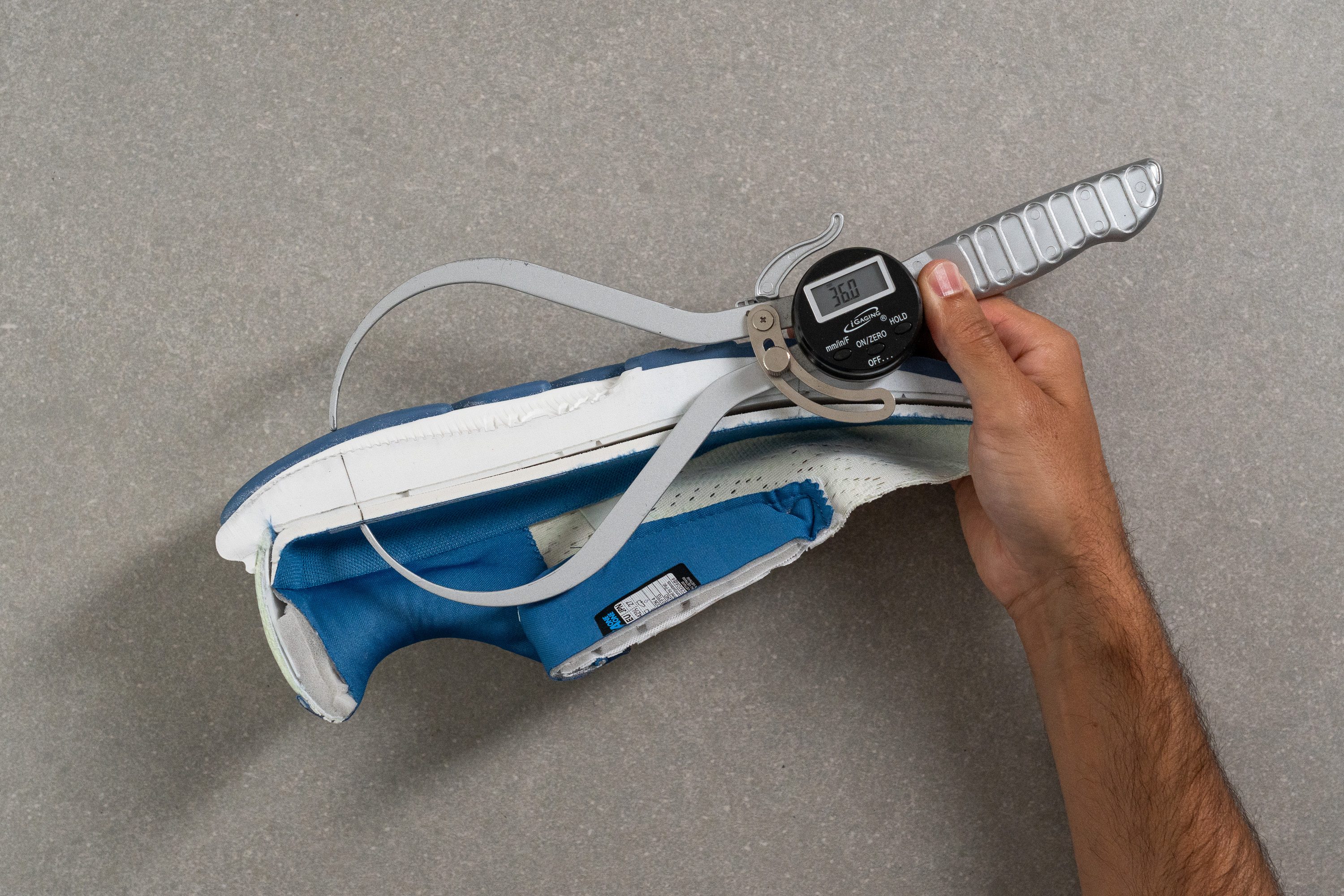
| Hoka Rincon 4 | 36.0 mm |
| Average | 34.8 mm |
Forefoot stack
The forefoot of the Rincon 4 measures a bit thinner than expected at 26.6 mm, yet it's still ample for a well-balanced daily trainer, fitting perfectly within its intended market. Therefore, we believe it's also a good option for forefoot and midfoot strikers—no issues here!
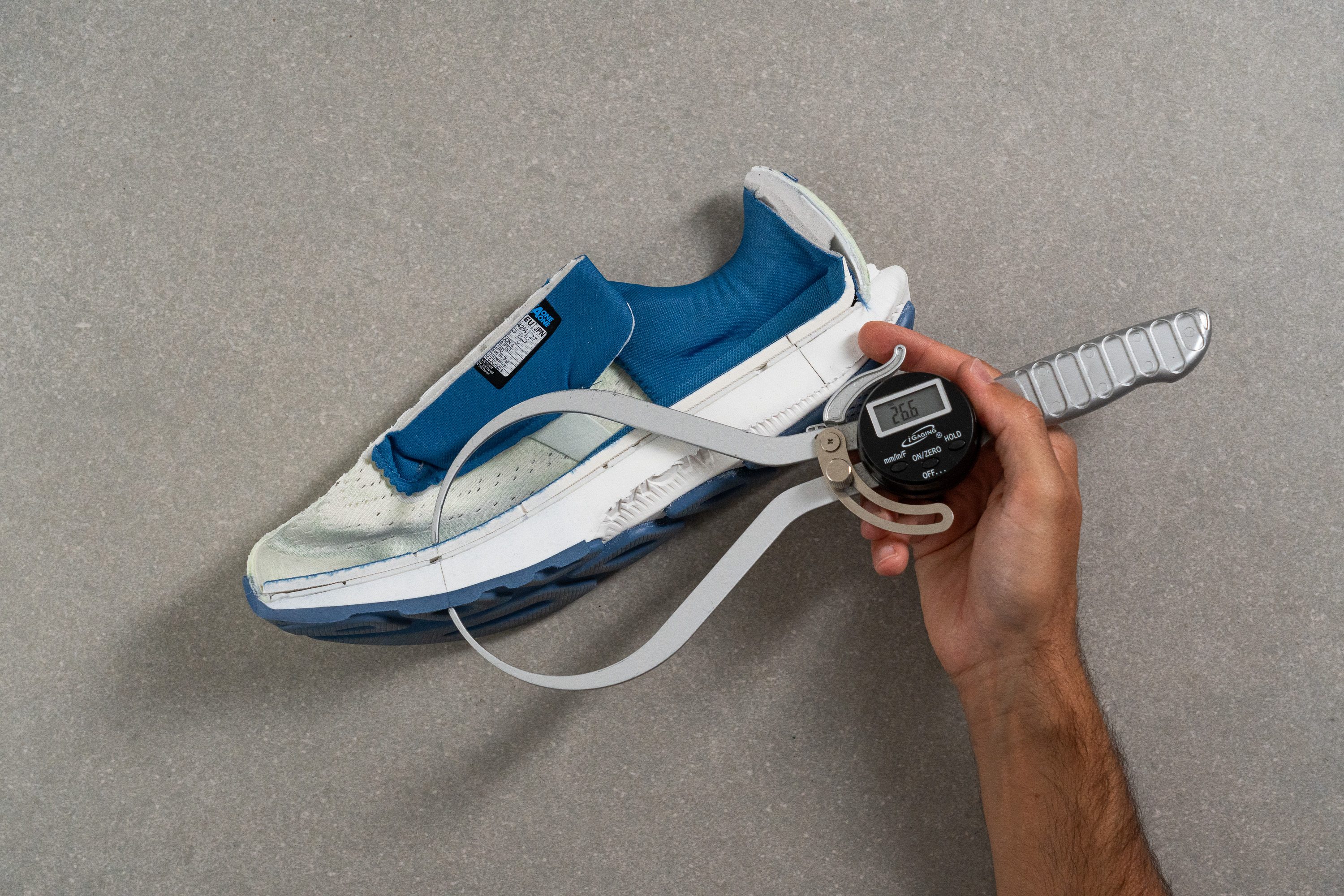
| Hoka Rincon 4 | 26.6 mm |
| Average | 26.2 mm |
Drop
Our analysis of the Rincon 4 revealed a 9.4 mm drop, notably higher than Hoka's stated 5 mm drop, highlighting a significant discrepancy.

If you're intrigued by these differences, we encourage you to consult our guide. It explains why brands' drop figures might vary from our lab measurements, which adhere to World Athletics guidelines.
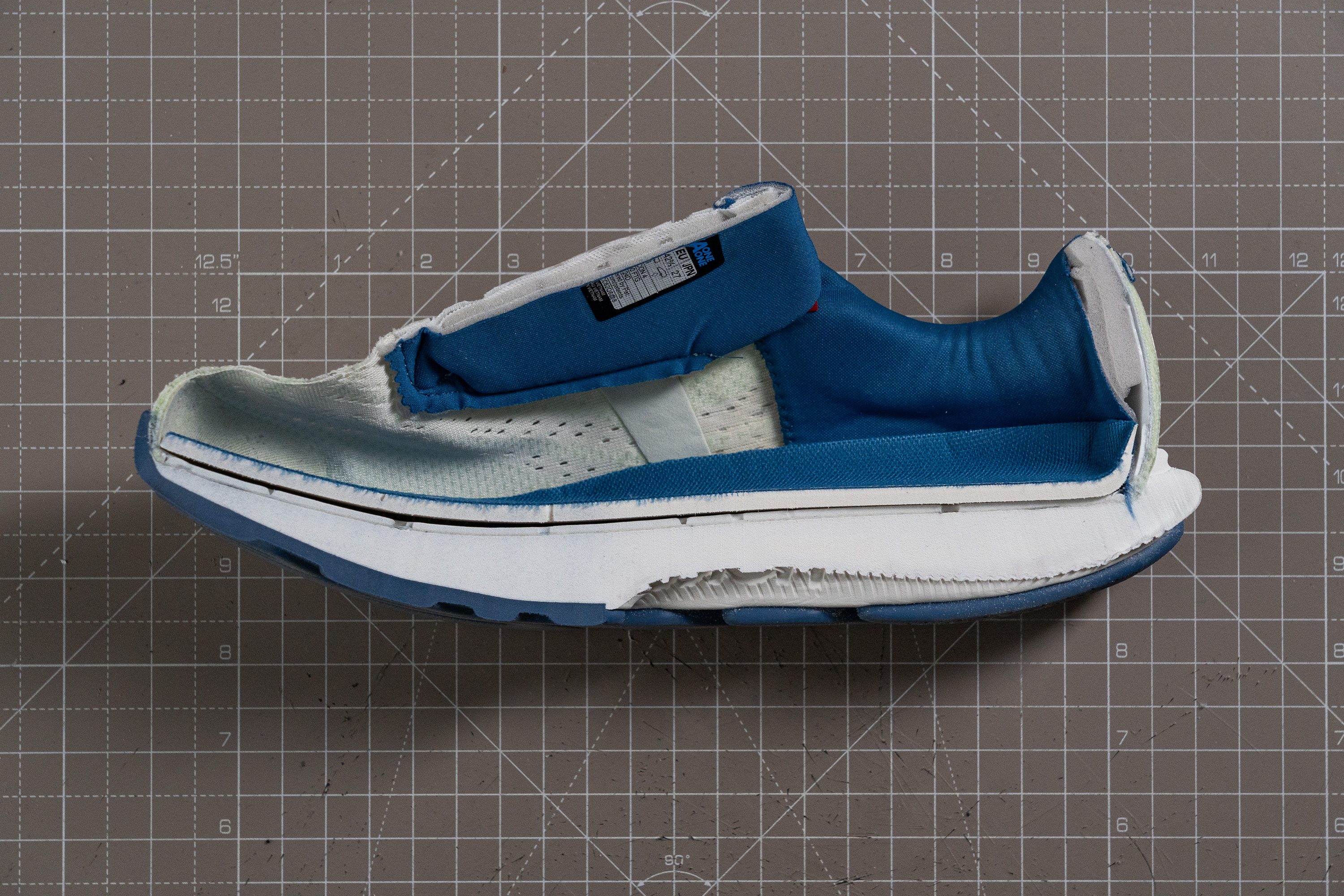
| Hoka Rincon 4 | 9.4 mm |
| Average | 8.6 mm |
Midsole softness
One of the critiques frequently levelled at the Rincon 3 by Hoka fans was its firm feel underfoot—we measured its midsole at 23.4 HA in our lab. The Rincon 4 addresses this with a plush 14.3-HA supercritical EVA foam, enhancing both softness and bounce.
What does this improvement mean? Essentially, it's still EVA, but now significantly more compliant and more responsive than its predecessor, marking a substantial improvement. Although stability might be slightly compromised due to the softer foam, we believe the trade-off for greater comfort is absolutely worth it.

| Hoka Rincon 4 | 14.3 HA |
| Average | 20.4 HA |
Rocker
We congratulate Hoka for the subtle rocker design from heel to toe in the Rincon 4—it's just enough to ensure an efficient and enjoyable ride. In our view, adding a more pronounced rocker to a shoe that lacks longitudinal stiffness would have been a significant misstep.
Size and fit
Size
Hoka Rincon 4 fits slightly small (127 votes).
Internal length
| Hoka Rincon 4 | 268.0 mm |
| Average | 269.5 mm |
Width / Fit
Hoka is well-known for its narrow-fitting shoes, but the Rincon has consistently been one of the better options for those seeking a roomier fit within this brand. The fourth version alters this trend slightly, as it's still roomier than most Hokas but narrower than average.
Our first measurement showed 92.4 mm at the upper's widest part, which is clearly below the typical width found in running shoes.

| Hoka Rincon 4 | 92.4 mm |
| Average | 95.1 mm |
Toebox width
Our second measurement, taken at the big toe area of our gel mold and recording 70.2 mm, revealed a toebox that tapers sharply—a characteristic Hoka design we had anticipated. That doesn't allow much room for toe splay.

| Hoka Rincon 4 | 70.2 mm |
| Average | 73.3 mm |
Toebox height
The trifecta of narrow measurements is rounded out with a 25.2-mm toebox height—once again falling well below the average.
In our view, this shoe is clearly designed for runners with low-volume feet.
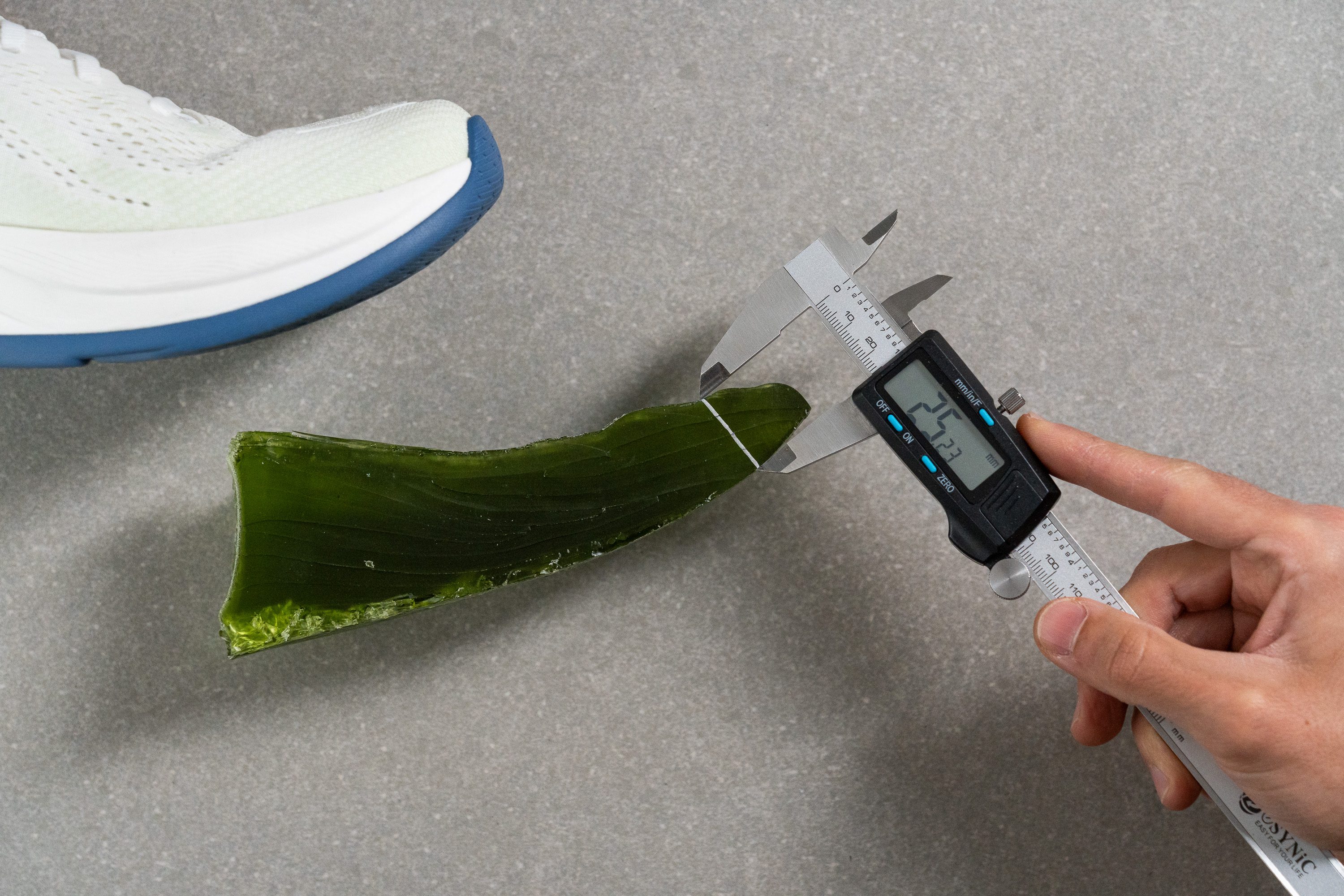
| Hoka Rincon 4 | 25.2 mm |
| Average | 27.1 mm |
Traction / Grip
Traction test
We tested the Rincon 4 with our wet-condition setup and found a score of 0.46. That’s a solid result for its price, even surpassing what we saw in the more expensive Hoka Bondi 9.
Thanks to this level of grip, you can expect top traction on dry roads and steady handling on wet surfaces, making the Rincon 4 a reasonable choice for a variety of runs.
| Hoka Rincon 4 | 0.46 |
| Average | 0.48 |
Outsole design
The Hoka Rincon 4 features a rubberized EVA outsole, a material we've encountered in only a few other shoes, like the ASICS Cumulus 26. The rarity of this material in footwear is often due to concerns about durability.
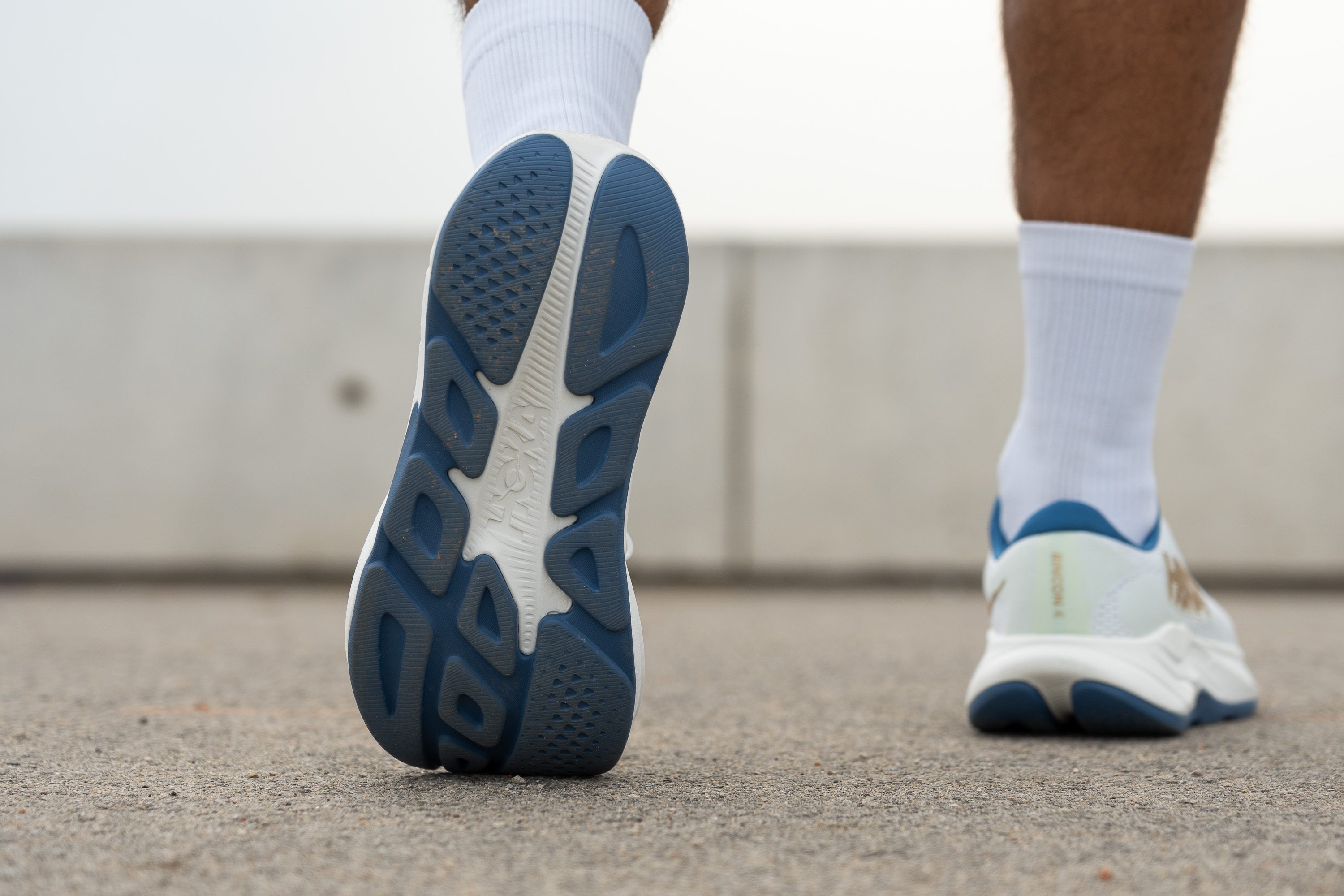
Flexibility / Stiffness
To assess its flexibility, we conducted our 30-degree bend test on the Rincon 4, where it registered 16.1N—a score that’s around the average. This flexibility makes this HOKA a versatile option for everyday use, although many potential users might have preferred a bit more flex.

| Hoka Rincon 4 | 16.1N |
| Average | 15.3N |
Stiffness in cold (%)
We conducted another cold-weather test, this time reassessing the stiffness of the material. The outcome showed a 28.4% increase, which is quite reasonable and marks a notable improvement.
| Hoka Rincon 4 | 28% |
| Average | 33% |
Weight
Following the durability downgrade from the Rincon 3, we've encountered another issue—the weight has increased from 7.35 oz (208g) to 8.1 oz (231g).
While staying just above 8 ounces is still impressive for any daily trainer, this weight gain is real. We are cautious, hoping that this increase is justified by significant improvements.
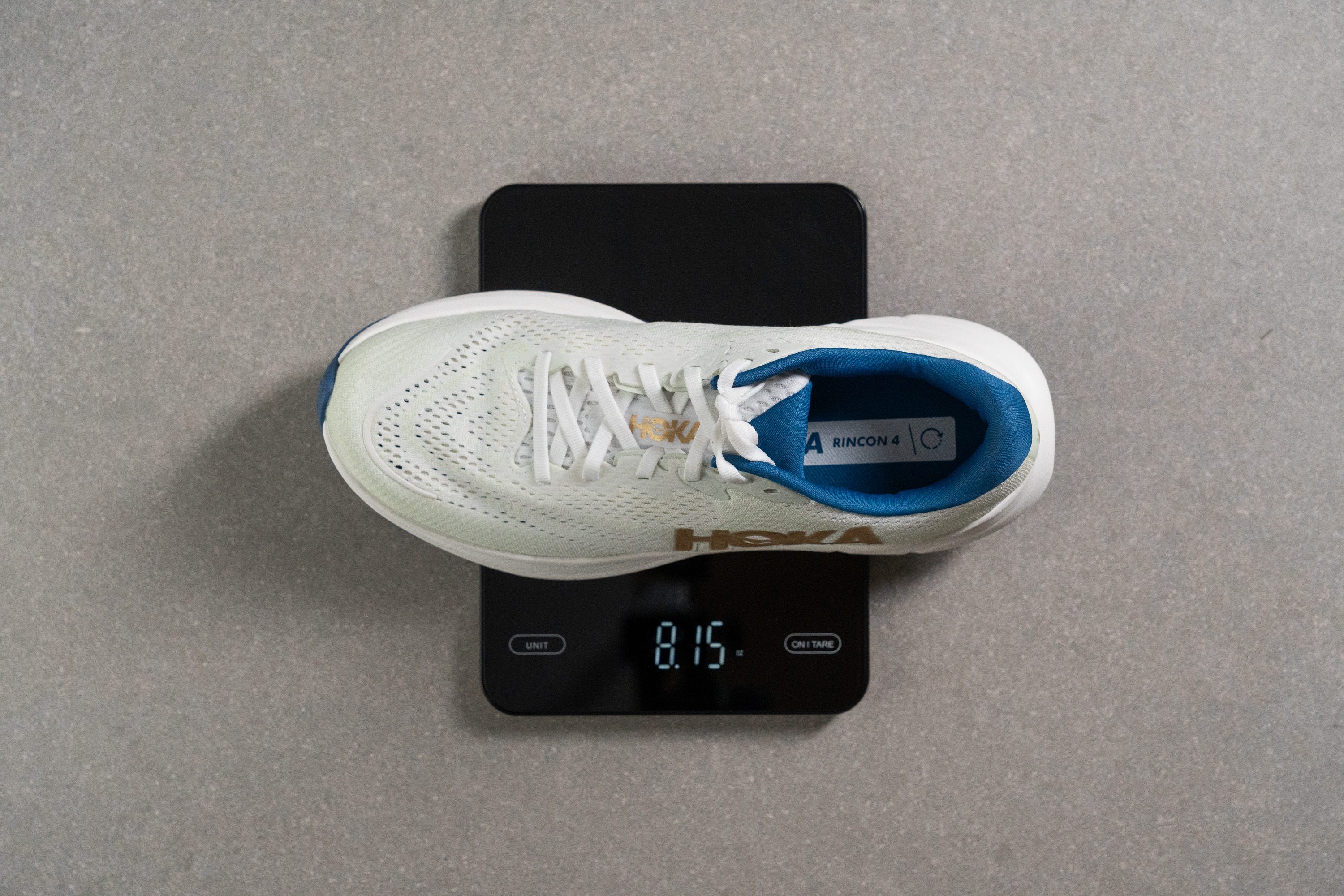
| Hoka Rincon 4 | 8.1 oz (231g) |
| Average | 9.3 oz (264g) |
Breathability
The Rincon 3 showcased excellent ventilation in our lab review, and we were eager to see if the Rincon 4 would maintain this high standard. Fortunately, our smoke tests confirmed that it indeed preserved its outstanding airflow, making it perfect for hot, scorching summers—a solid 5/5 from us.
This shoe impressed us again during our light test, confirming its breathability. While the toebox allows light to pass through effortlessly, ensuring superb ventilation, the midfoot and heel sections are robustly structured, providing necessary lateral support for those with light pronation issues.
Turning to the microscope, we discovered that Hoka used a different material than in the previous version for the Rincon 4.

This time, it features a simple engineered mesh with ventilation holes across the toebox, which enhances breathability.
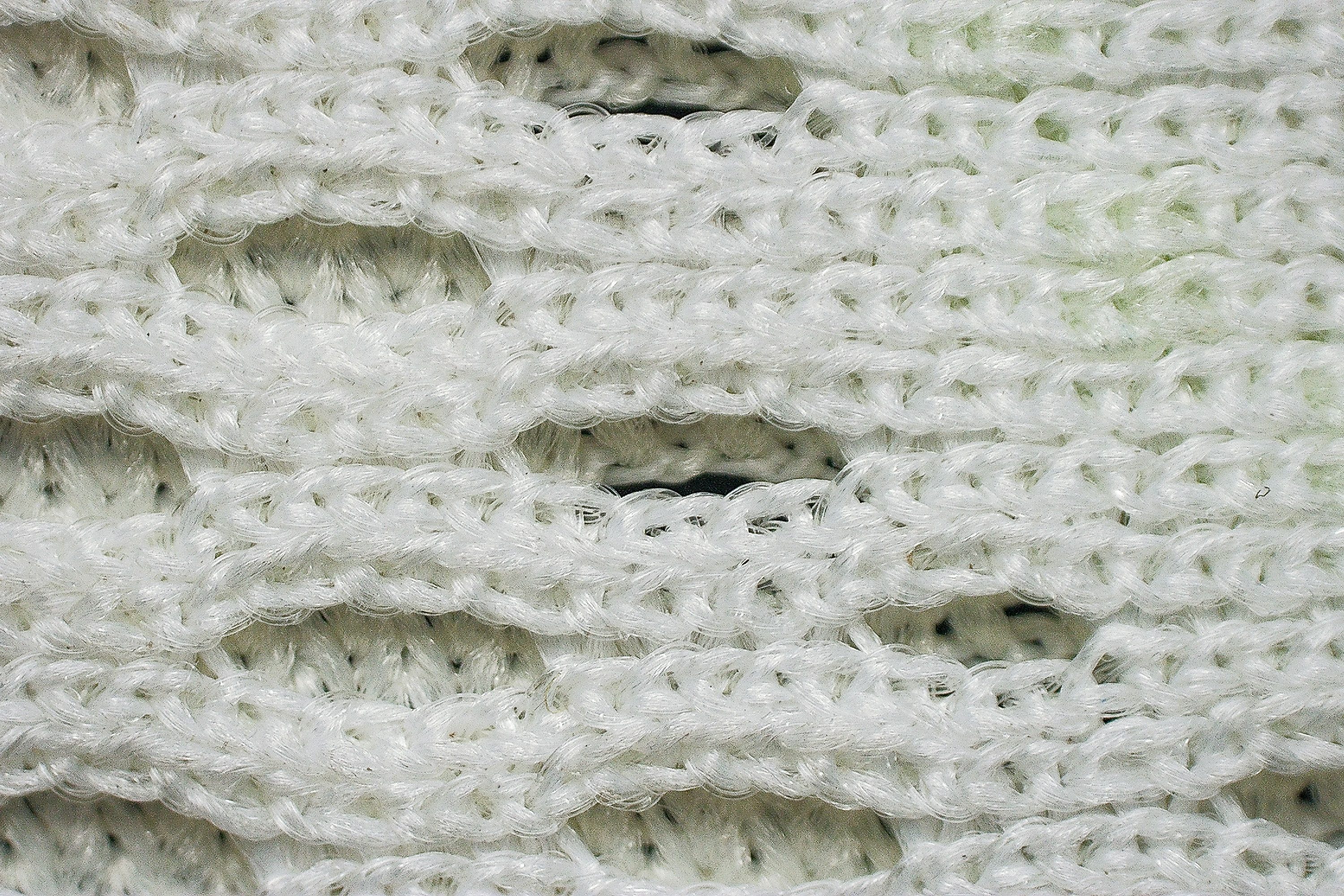
The Rincon 4’s upper might be no-frills, but it excels in ventilation, offers sufficient padding, and is free from rough spots.
We also appreciated that, complementing the excellent upper ventilation, Hoka included a perforated insole—typically found in premium models. This was a delightful surprise in such an affordable shoe.
| Hoka Rincon 4 | 5 |
| Average | 3.7 |
Stability
Lateral stability test
For us, despite being marketed as a neutral shoe, the Rincon 4 works as a mild-stability trainer too, addressing the needs of a broad spectrum of runners.
Hoka has again shifted away from traditional stability mechanisms, instead opting for subtle techniques like midsole sidewalls, outsole cutouts and a slightly rockered design, which all contribute to a more natural form of stability for every runner.
Torsional rigidity
We found it quite challenging to bend or twist the Rincon 4 by hand, highlighting its impressive torsional rigidity. As a result, we awarded the shoe a notable score of 4 out of 5, placing it on par with shoes that feature nylon plates.
| Hoka Rincon 4 | 4 |
| Average | 3.5 |
Heel counter stiffness
The heel counter in the Rincon 4 is stiffer than what is typically found in daily trainers, a characteristic that aligns well with its intended use case. However, at 4/5, it's not as ultra-stiff as the one in the Hoka Skyward X, and we appreciate it.
| Hoka Rincon 4 | 4 |
| Average | 2.9 |
Midsole width - forefoot
We used our digital caliper to measure the midsole dimensions of the Rincon 4, starting with the forefoot. And we discovered one reason for the weight increase from the third edition—the forefoot is now wider, measuring 116.3 mm compared to the previous 113.2 mm.
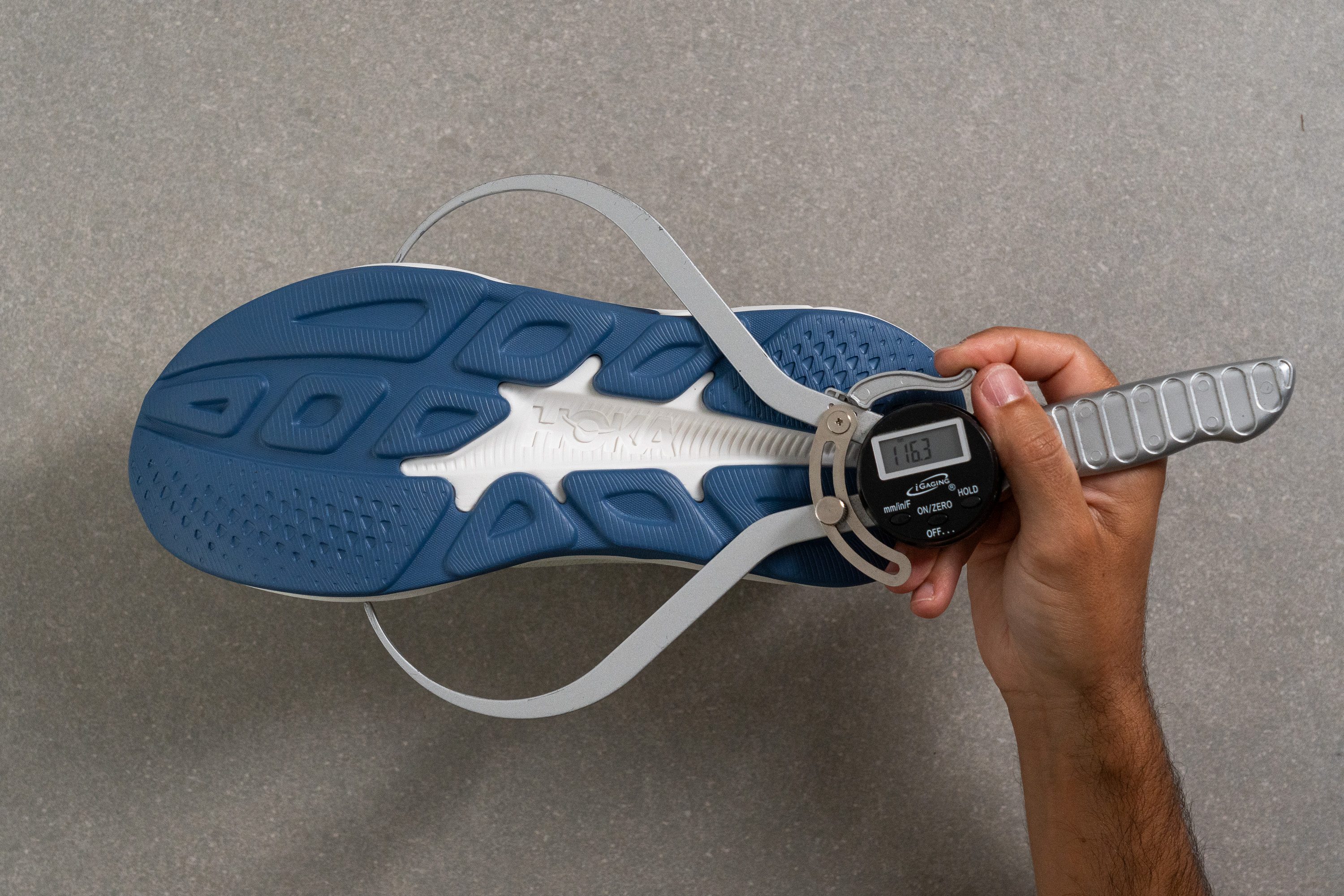
| Hoka Rincon 4 | 116.3 mm |
| Average | 114.4 mm |
Midsole width - heel
Here's another significant design improvement in the Rincon 4 that subtly enhances stability: with its 97.0 mm width and an incredibly broad midfoot, the shoe offers excellent support for heel and midfoot strikers.
This feature effectively provides just the right amount of support, helping these runners maintain a more neutral stride with ease.
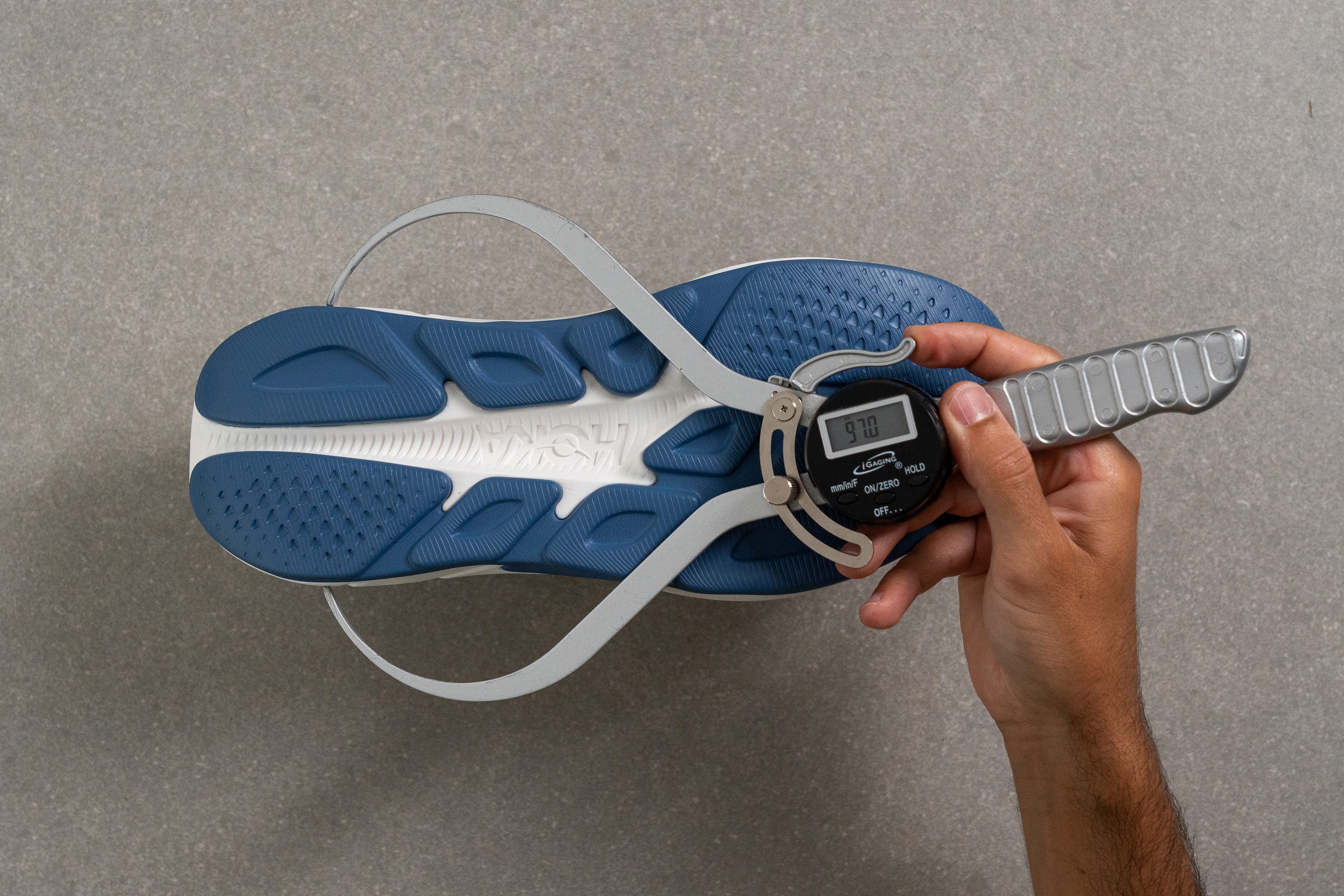
| Hoka Rincon 4 | 97.0 mm |
| Average | 90.7 mm |
Durability
Toebox durability
Given the Rincon 4's extremely thin upper, we were braced for a less-than-ideal outcome in our Dremel test, yet we did not expect such a teeth-grinding result.
When the tool finished, we discovered a complete hole in the upper, confirming our worst concerns—undeniably a 1/5 rating.
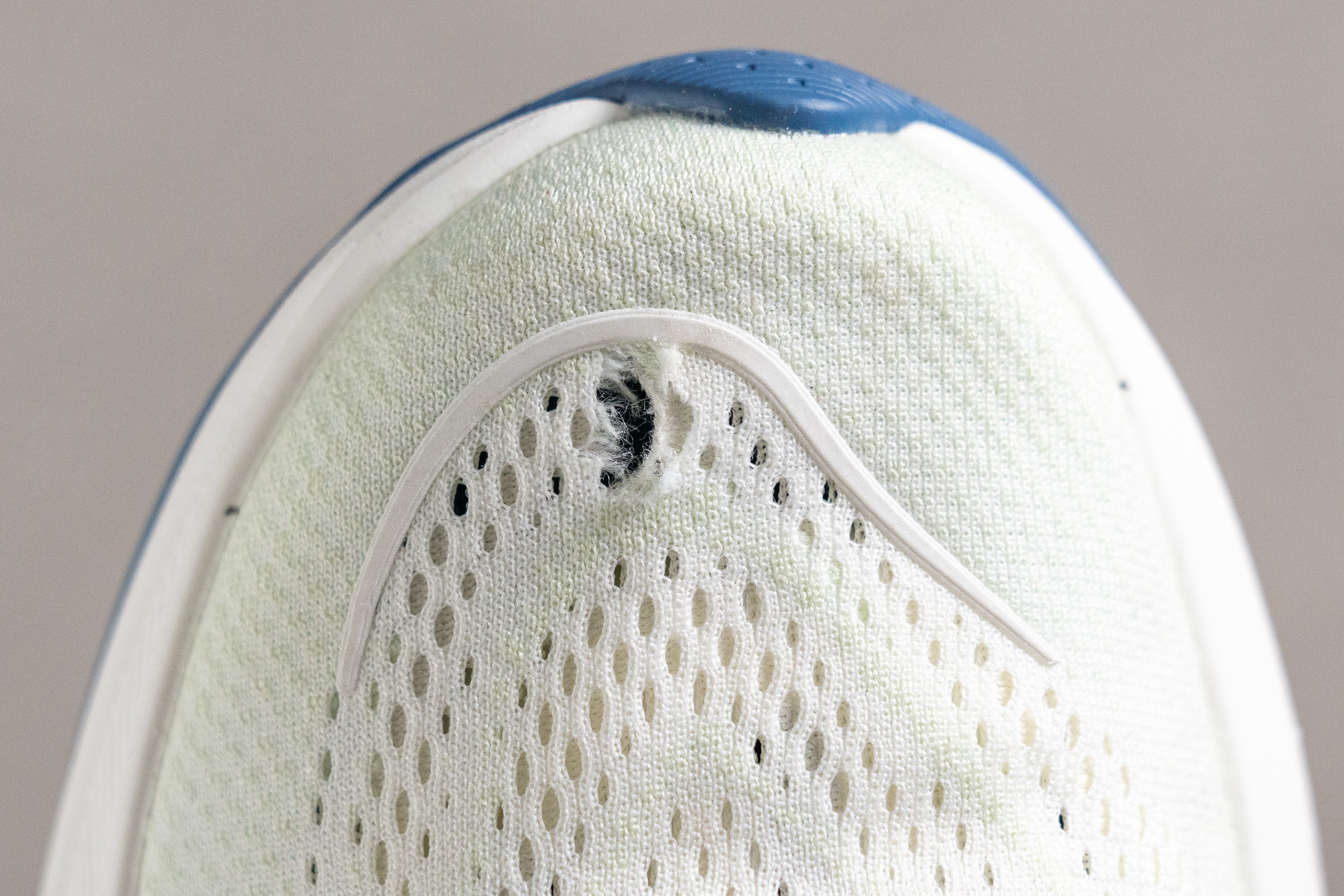
| Hoka Rincon 4 | 1 |
| Average | 2.6 |
Heel padding durability
Turning our attention to the heel padding, we noted that while it couldn't possibly be worse than the toebox, the slight improvement we observed was still clearly inadequate.
Scoring a mere 2/5, it falls significantly below the average, and raises concerns about durability all around the Rincon 4.
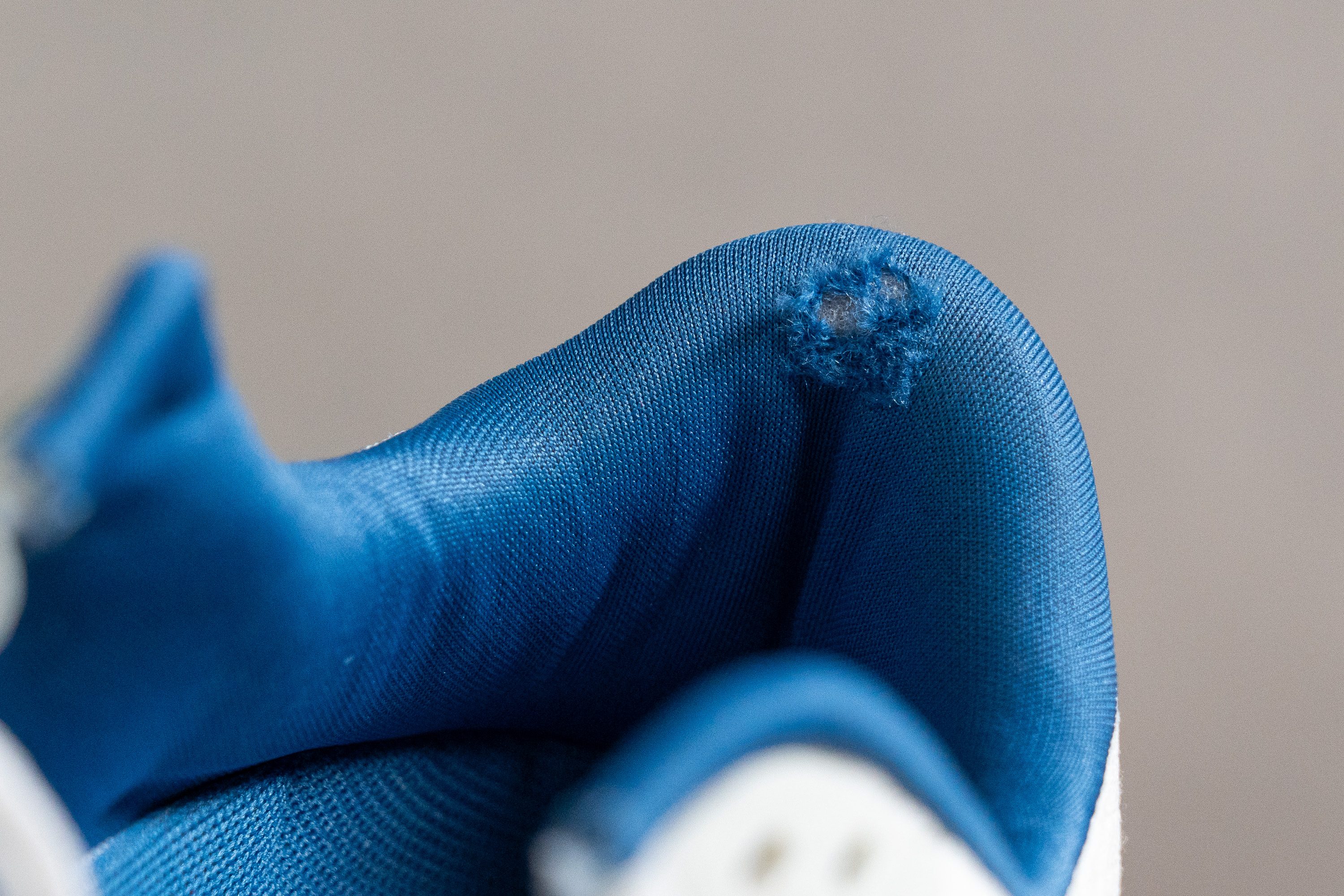
| Hoka Rincon 4 | 2 |
| Average | 3.4 |
Outsole hardness
The Hoka Rincon 4 features a rubberized EVA outsole, a material we've encountered in only a few other shoes, like the ASICS Cumulus 26. The rarity of this material in footwear is often due to concerns about durability.

So, what exactly is a rubberized outsole? It's basically a hybrid between an EVA midsole and a regular outsole. It offers a softer composition (55.8 HC), providing even some decent energy return and good grip. However, it typically falls short in terms of durability—let's find out if that's the case.
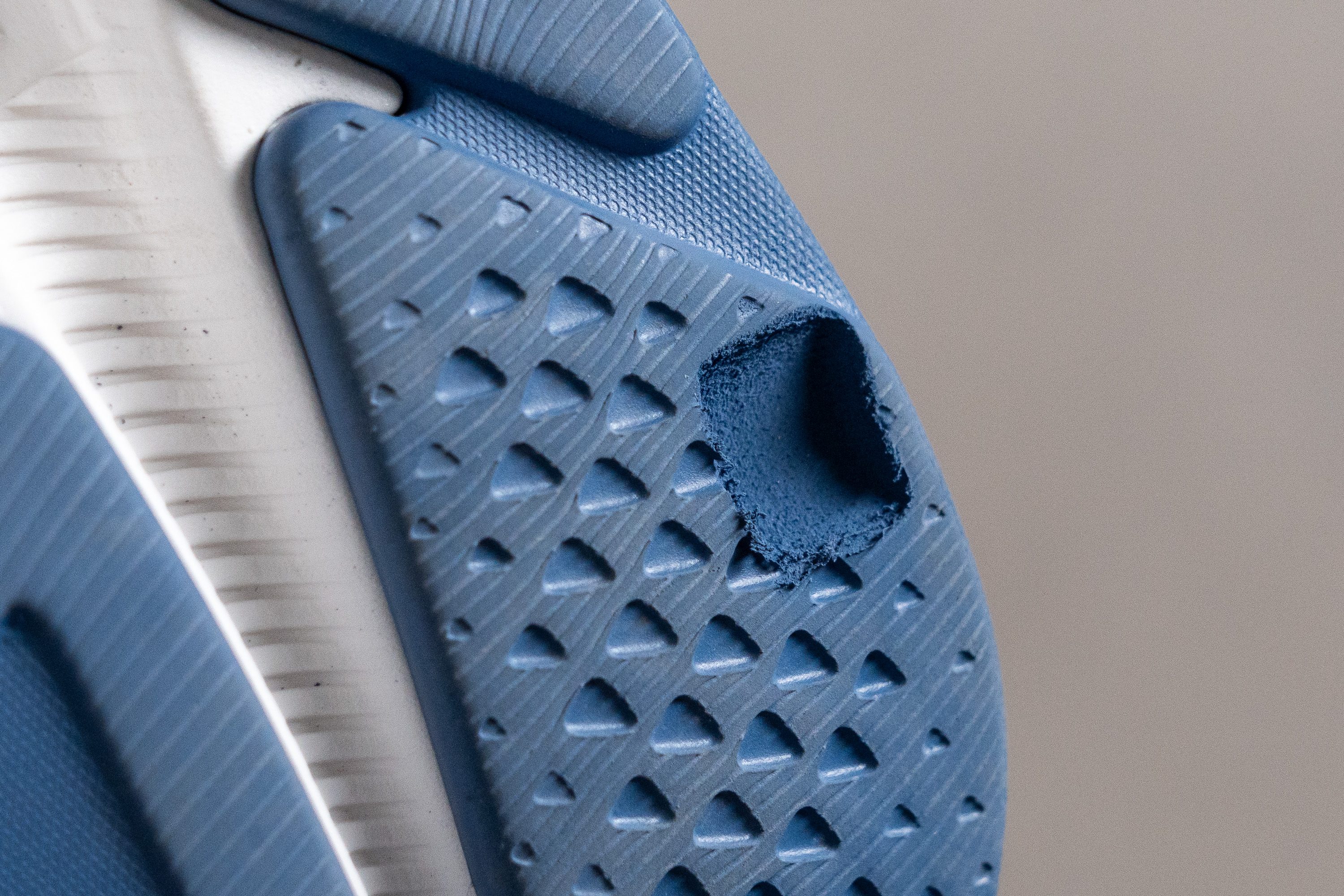
| Hoka Rincon 4 | 55.8 HC |
| Average | 79.2 HC |
Outsole durability
Unfortunately, as we anticipated due to the soft material we discovered, the Dremel test almost completely destroyed the outsole.
In fact, at 6.5 mm of damage, this was one of the poorest performances we've ever recorded in our lab during such tests. But are we surprised? Not at all—this is typical for a rubberized EVA outsole. While it offers benefits like a smoother ride, it significantly lacks durability.

| Hoka Rincon 4 | 6.5 mm |
| Average | 1.1 mm |
Outsole thickness
The outsole boasts an exceptional thickness of 6.6 mm—more than double the usual standard.
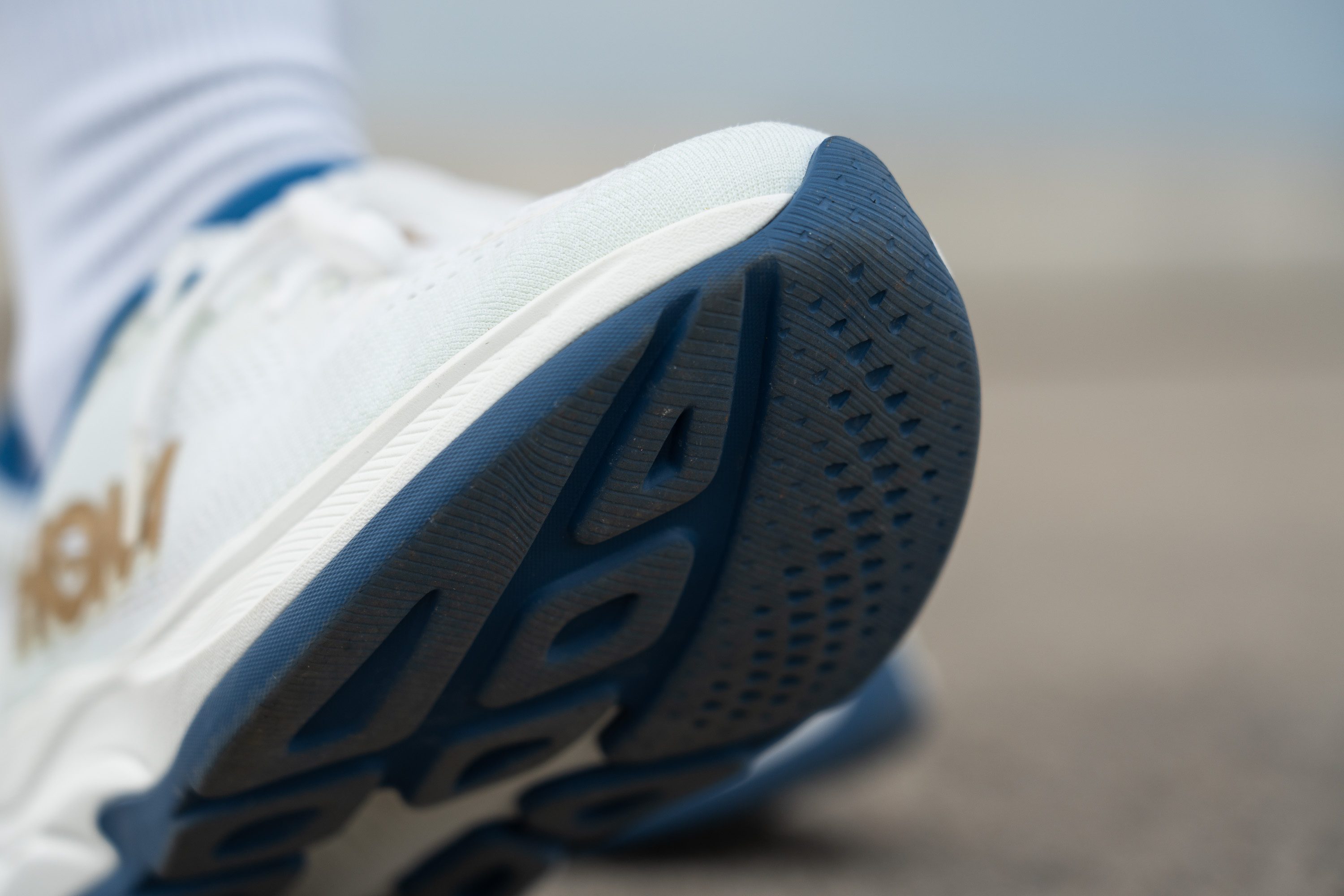
This increased thickness is essential to compensate for the material's inherent lack of durability. It's a smart and necessary design adjustment compared to almost any other running shoe.
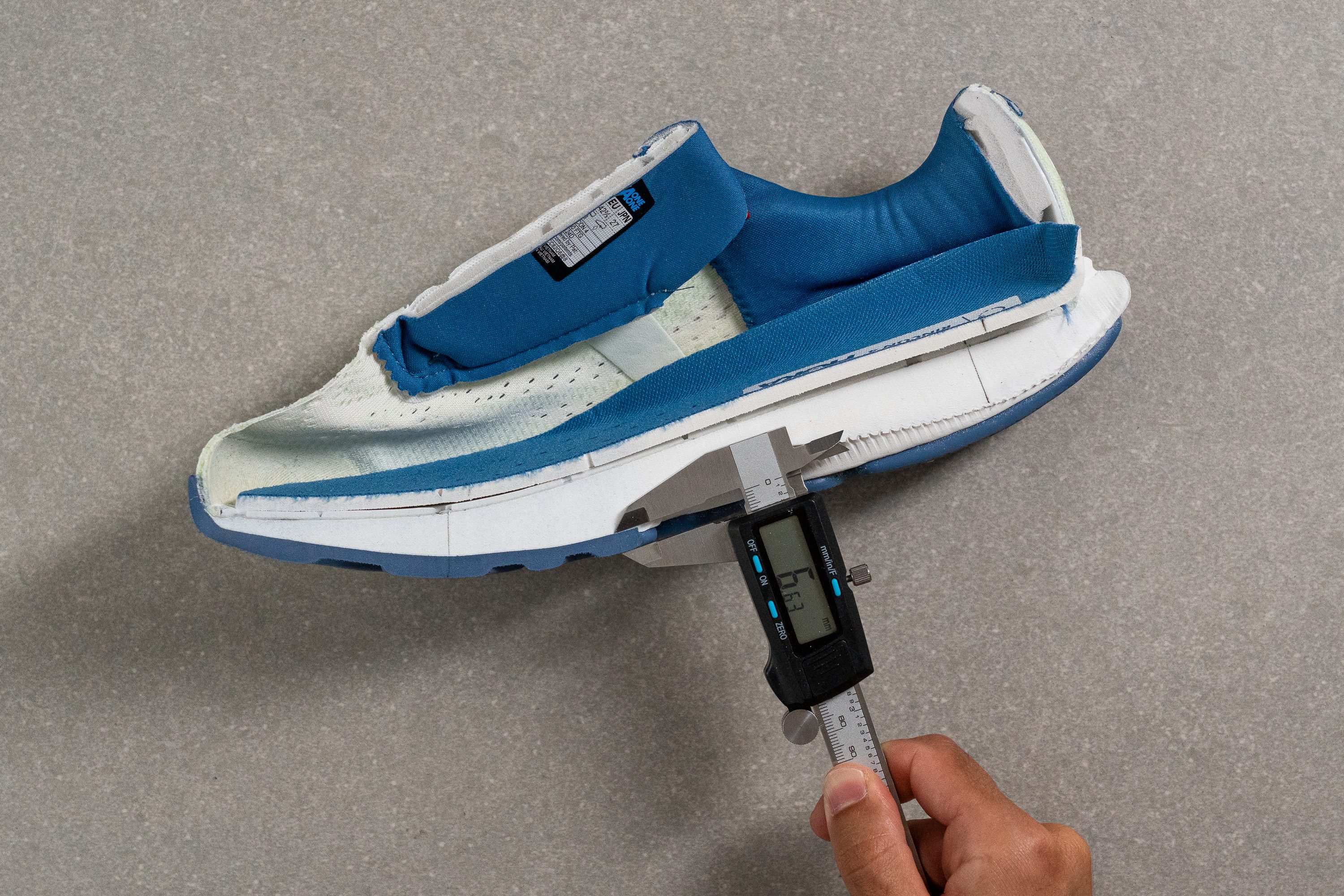
| Hoka Rincon 4 | 6.6 mm |
| Average | 3.2 mm |
Misc
Insole thickness
The insole is crafted from EVA and is quite standard, offering a comfortable feel with its 4.8 mm thickness, which is close to the average.
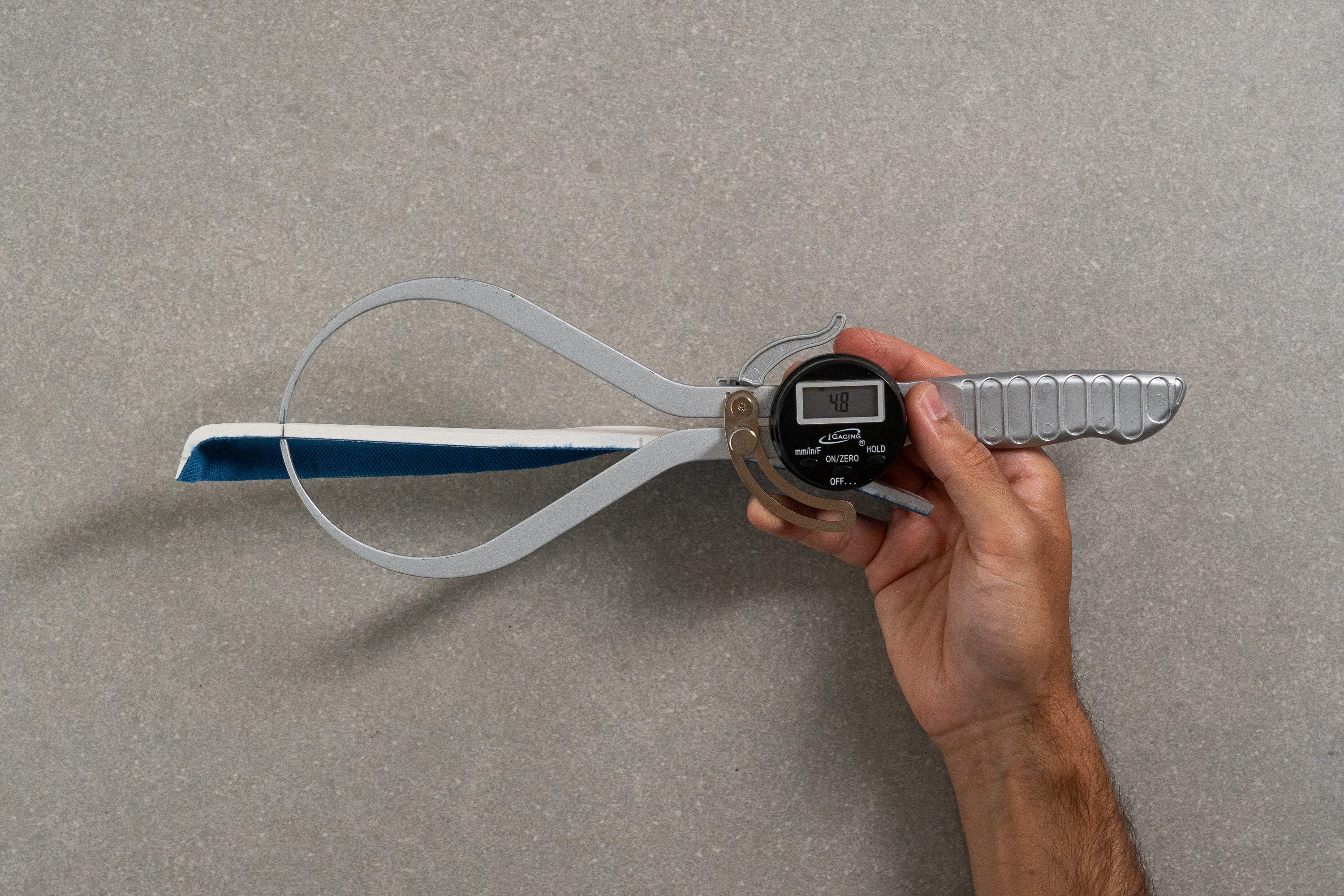
| Hoka Rincon 4 | 4.8 mm |
| Average | 4.5 mm |
Removable insole
We didn't find any issues when removing the stock insole from the Rincon 4, nor did we encounter problems when inserting footbeds from other shoes.
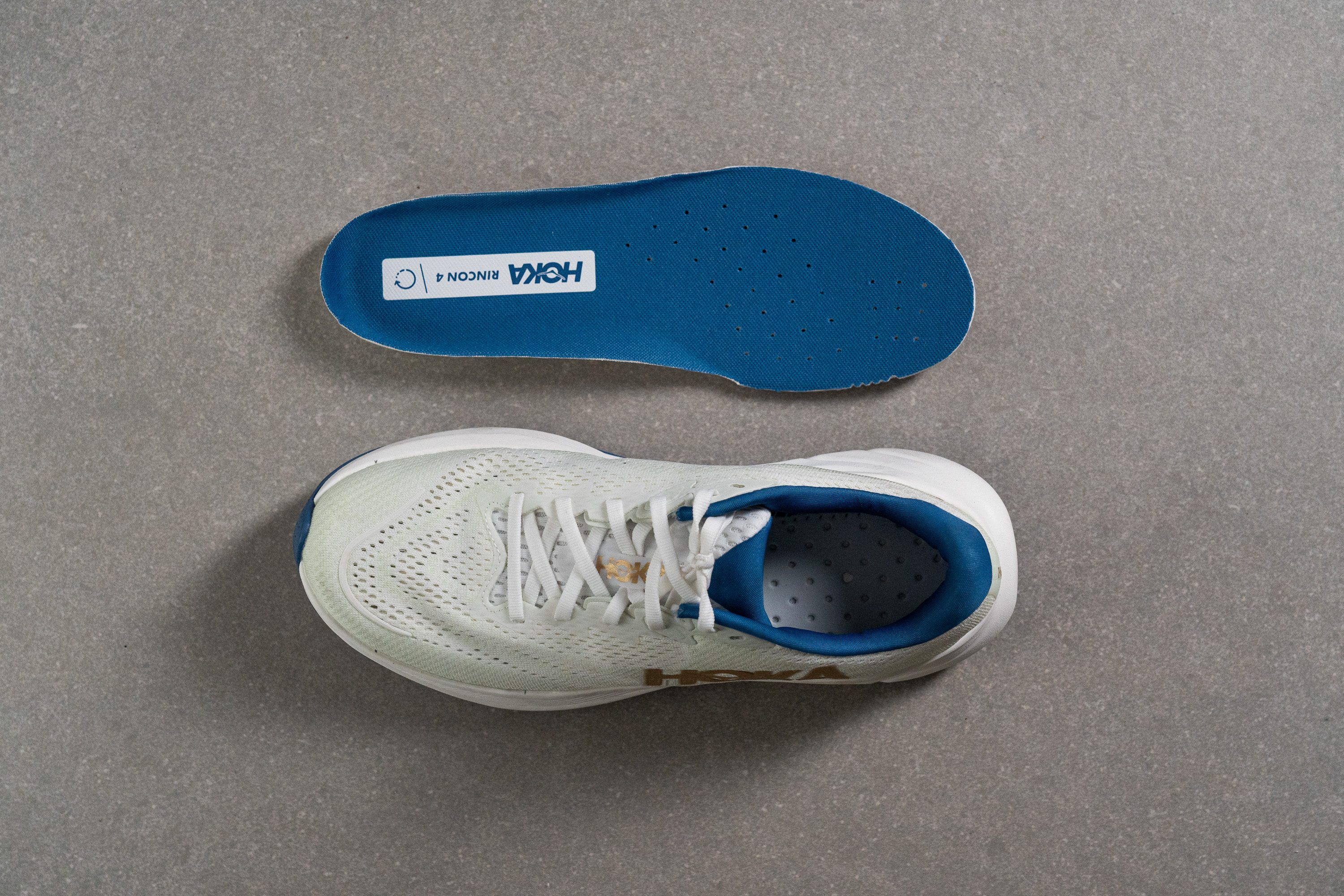
| Hoka Rincon 4 | Yes |
Midsole softness in cold (%)
While the Rincon 4's midsole marks a real advancement over the Rincon 3, it is still made of EVA, which we've found to significantly underperform in cold temperatures. Our tests revealed that this midsole became 43.9% firmer in cold weather.
This drastic change, paired with the shoe's highly ventilated upper, makes the Rincon 4 a poor choice for those living in areas with harsh winters.
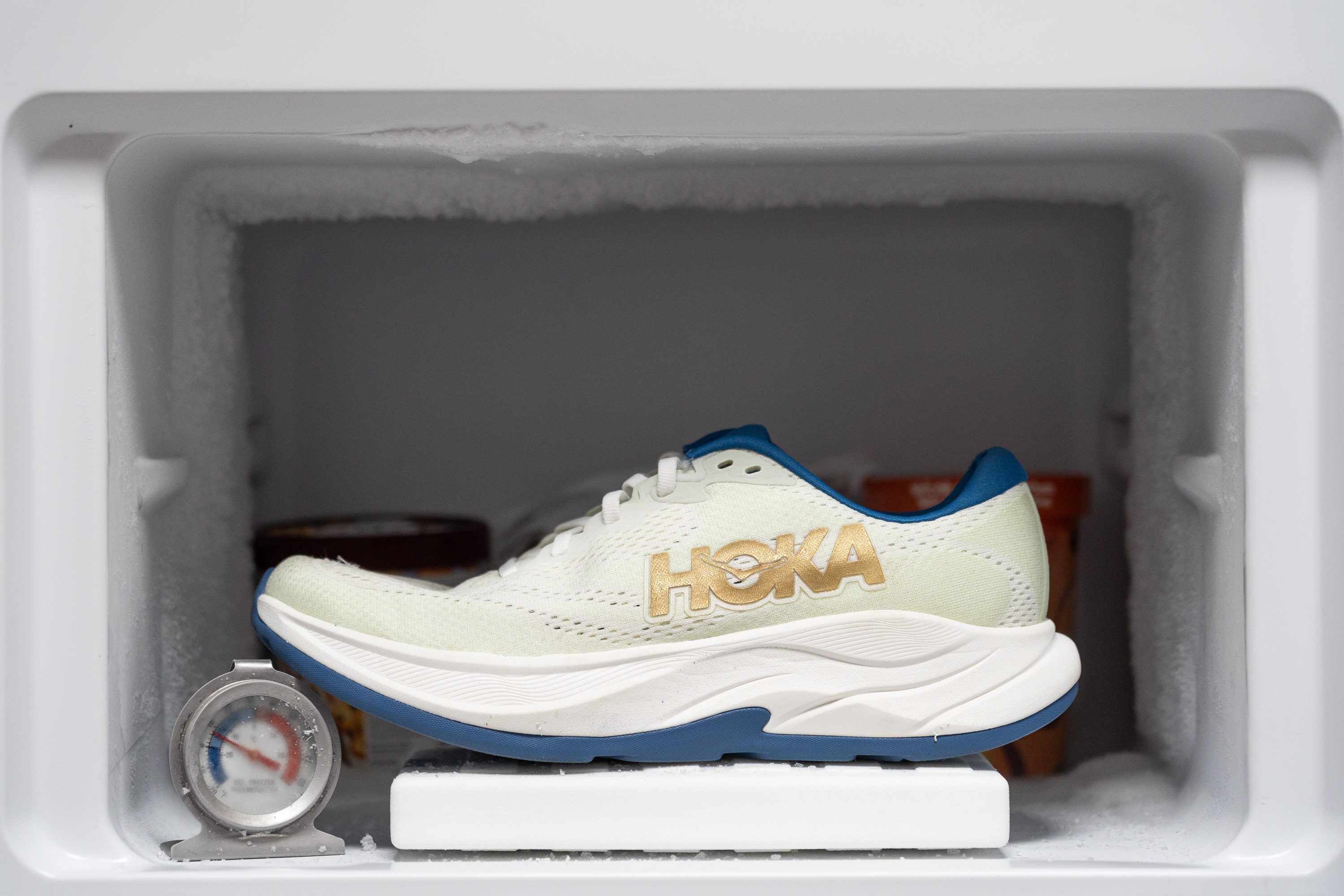
| Hoka Rincon 4 | 44% |
| Average | 24% |
Reflective elements
Yes! While it's surprising that Hoka is omitting reflective elements in its pricier models like the Skyward X, we're pleased to see that they've included some in the Rincon 4.
| Hoka Rincon 4 | Yes |
Tongue padding
We measured 6.7 mm of padding in the tongue of the Rincon 4, which we found to be ideal for a daily trainer—it's neither too thin nor excessively padded, thus avoiding unnecessary weight.
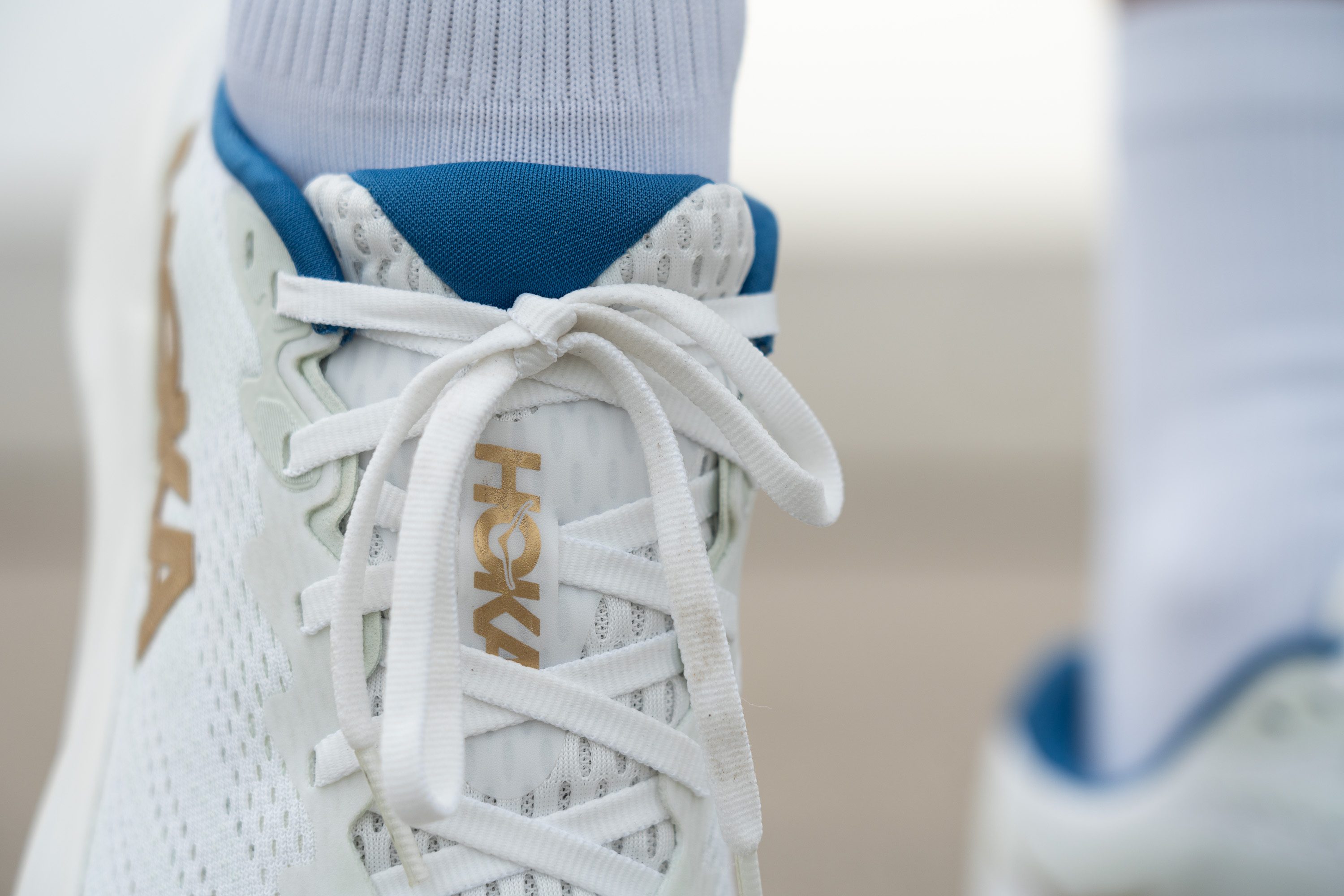
We also appreciated the straightforward lacing system of the Rincon 4. Made from punched eyelets without loops or wires found in other running shoes, it functions flawlessly, which is crucial for us.
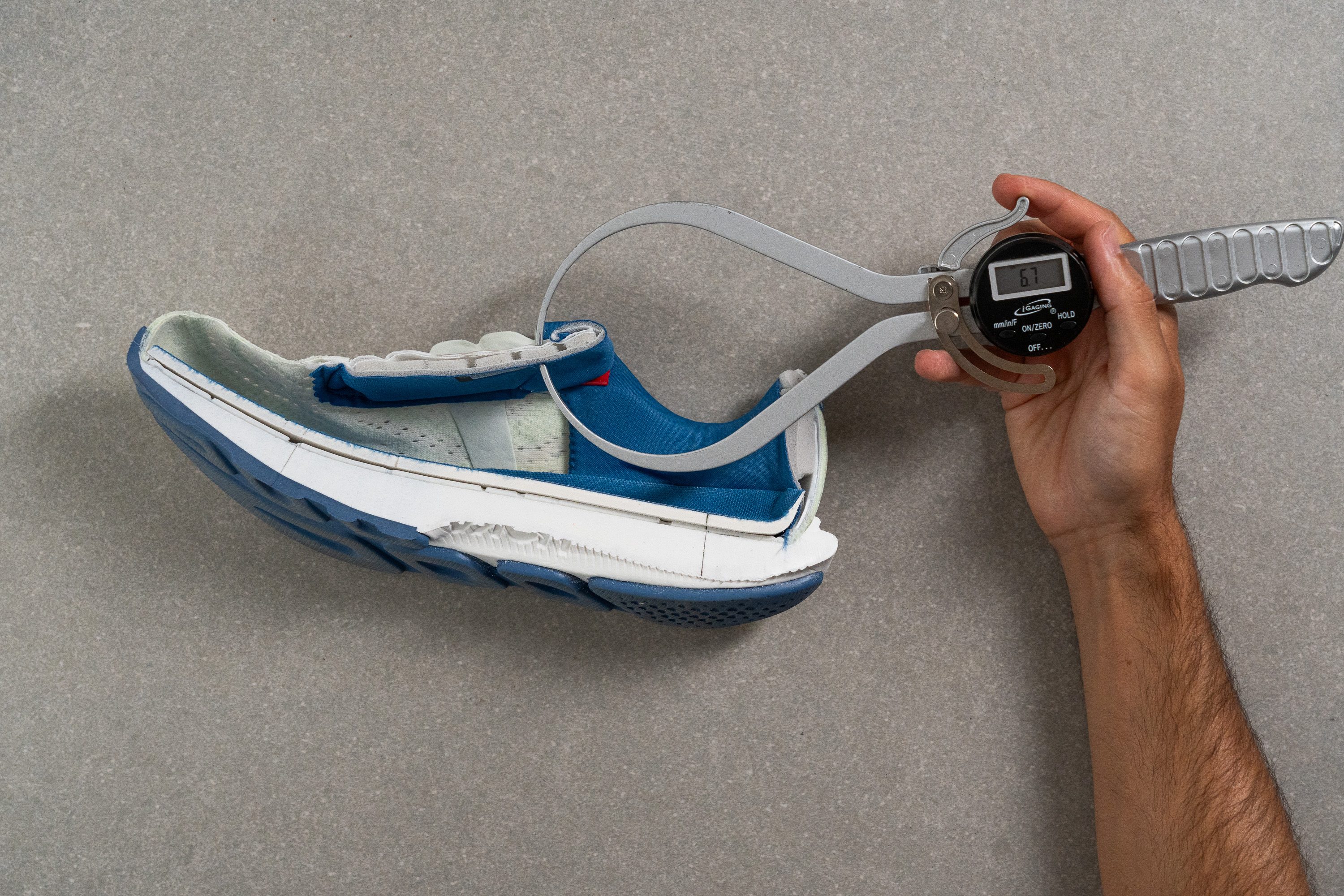
| Hoka Rincon 4 | 6.7 mm |
| Average | 5.8 mm |
Tongue: gusset type
The Rincon 4 disappointingly lacks a gusseted tongue—a feature that would have significantly improved its lockdown. However, at a price point of just £130, we didn't really expect to find one included in most shoes.
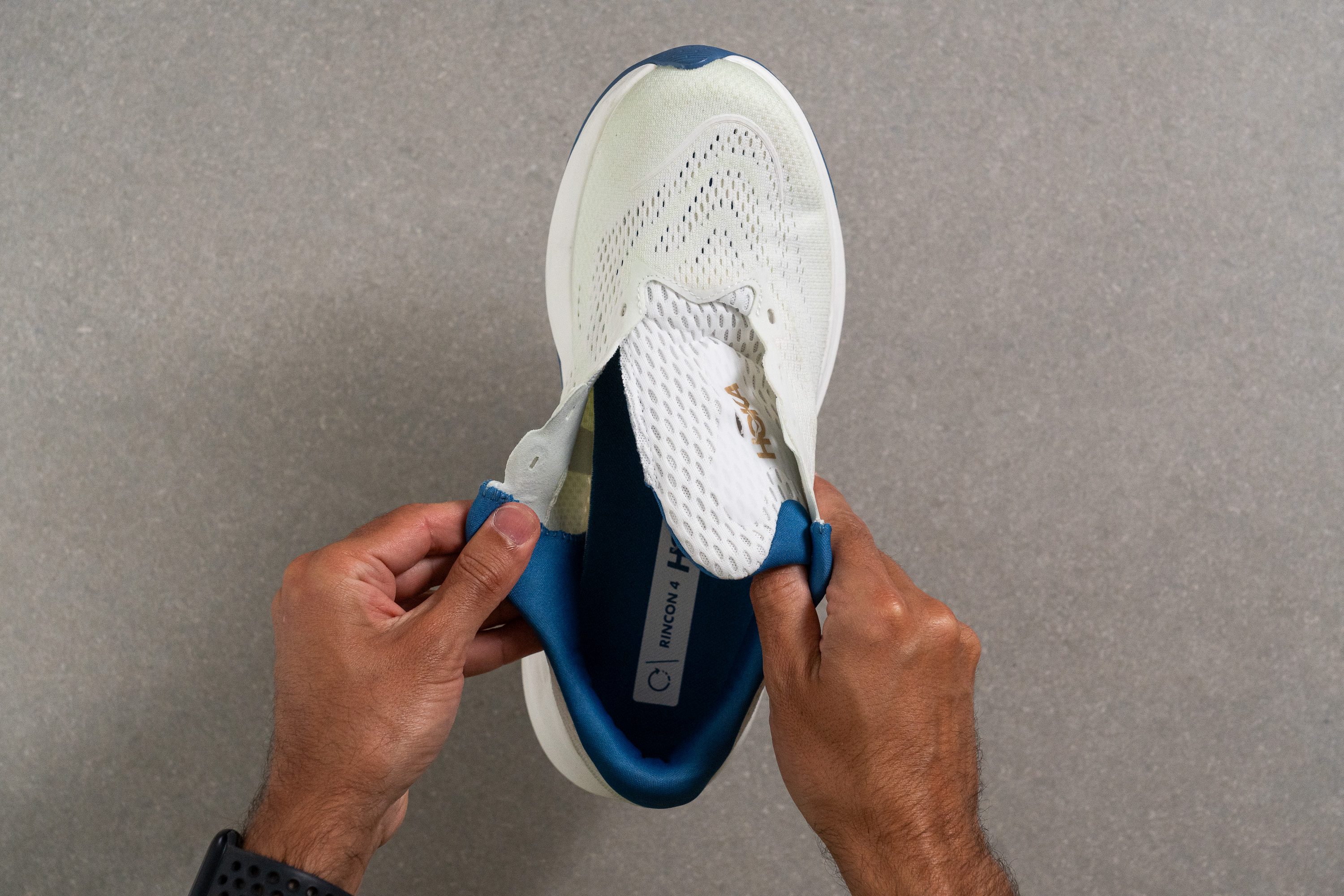
| Hoka Rincon 4 | None |
Heel tab
The Rincon 4 lacks both a finger-loop heel tab and the extended heel collar found on many other Hoka models. We believe this design choice underscores its position as an entry-level option within the Hoka lineup.
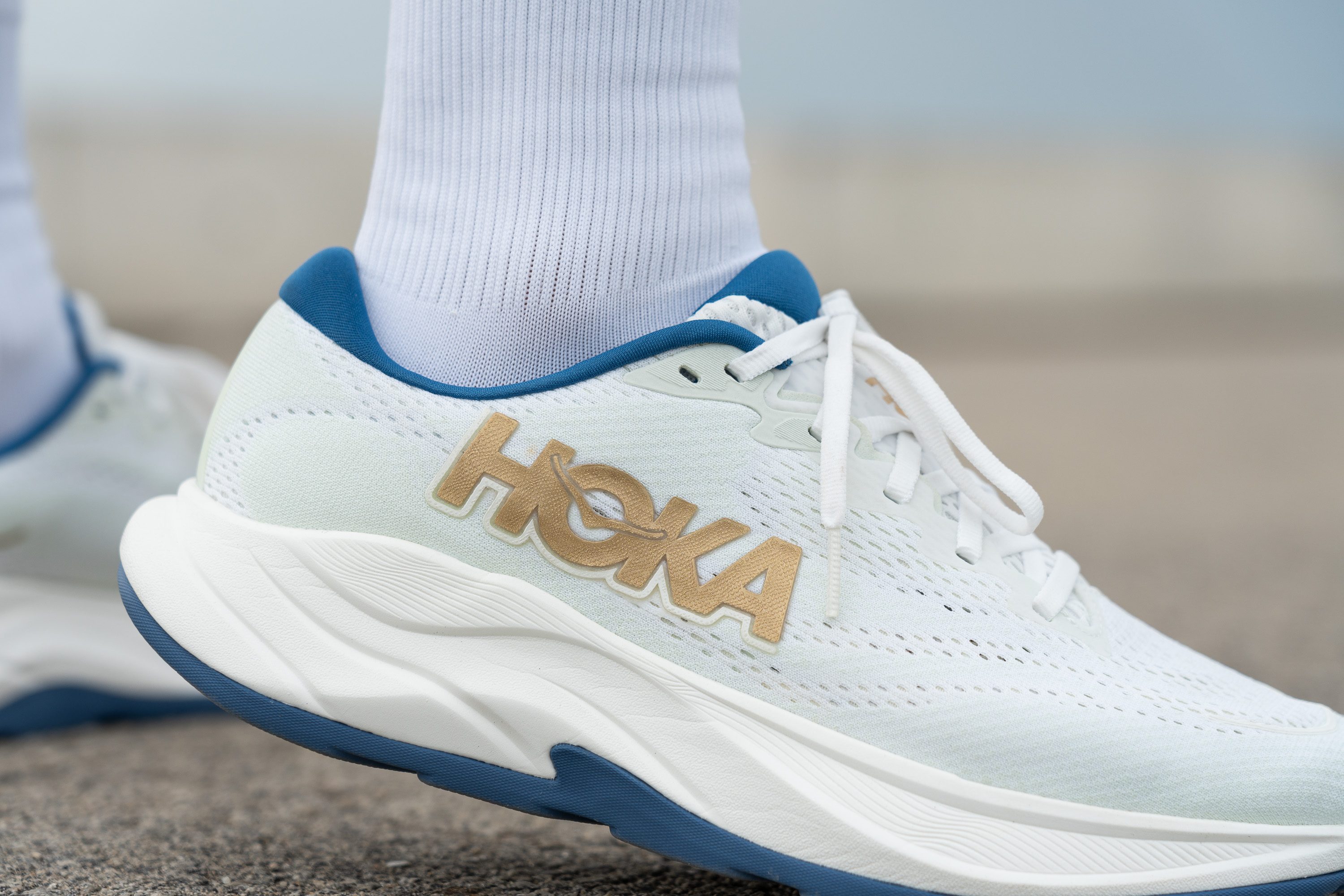
| Hoka Rincon 4 | None |

